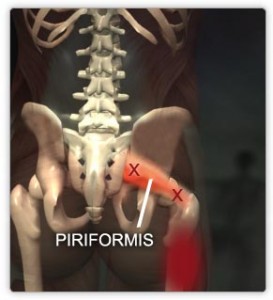
So, have you ever experienced pain in the buttock that radiates down into the thigh? Maybe even felt some numbness and tingling? Recently, I was contacted by an experienced marathoner who has been plagued by pain in the buttock and posterior thigh. He self diagnosed himself as having piriformis syndrome after doing some research on the Internet. So. what is piriformis syndrome?
Some experts debate whether it truly exists, but essentially, it involves the piriformis, a small pear shaped muscle in that helps externally rotate (turn out) the hip and the sciatic nerve which runs down the entire back of the leg and is responsible for sensation and motor movement patterns of many of the muscles in the lower leg.
It is suggested that in this syndrome the sciatic nerve essentially becomes compressed or irritated by a tight piriformis muscle. The sciatic nerve travels above, below or even through the piriformis muscle itself based on anatomical studies.
Some have even suggested that prolonged sitting with the hips turned out or sitting on a wallet can contribute to this problem. I even remember being told in PT school that it is more common in truck drivers. With that said, I think I can count on one, if not both hands the number of patients I have seen in 15 years that I truly believe had piriformis syndrome.
Now back to my runner. He began having pain in his left buttock and hamstring in late December after seeing a trigger point specialist who suggested he had a tight piriformis and did some deep tissue work on it. A short time afterward, he began having symptoms. He saw a physical therapist for 2-3 sessions and was given some stretches to do. Meanwhile, he began getting deep tissue massage focused on the area in January and February.
When I spoke to him by phone he reported no relief to date. I interviewed him and encouraged him to come in for an evaluation to determine the root cause of his problems. I suspected his problem was more likely related to his back and not his piriformis. He already has had an x-ray ruling out stenosis (narrowing of the spine) but notes that driving (particularly pressing the gas) and running greater than 3 miles bring on the symptoms.
Here are some key findings of my evaluation:
- Left hamstring pain worse with forward spinal flexion in standing
- Repeated flexion in standing also increased hamstring pain/tension
- No pain with resisted hip external rotation
- No pain with passive stretch of the piriformis (hip internal rotation)
- Increased tension/soreness with passive straight leg test (raise) on the left leg
- Marked palpation tenderness over the left greater sciatic notch
- Pain free prone prop and press-up maneuver
So, at this point I feel confident in telling my patient that he clearly has sciatic nerve irritation. You may be thinking that this would be true with piriformis syndrome anyway, and you would be correct. However, in this case, his symptoms are reproduced with mechanical spinal flexion and NOT hip rotation. If the piriformis were to blame, one would expect that increasing tension on the muscle would reproduce the pain and symptoms – not so here.

This is a key differentiating factor in my mind. The few patients I have seen with piriformis related issues have seen their symptoms reproduced with hip provocation tests – my client did not. Was his piriformis tight? Yes, to a certain extent, but not dramatically more so than his other side. Consider this: he has been doing hip stretches for almost 2 months and has had at least 6 massages targeting the area so far.
To date, he has had zero relief and has even cut back his running. In my mind, the massage has only served to perpetuate or maybe worsen his symptoms simply because digging the elbow and hands into the piriformis when the sciatic nerve is inflamed (sciatica) only serves to increase the inflammation of the nerve itself given the location of the nerve.
This is to a large extent why he has not gotten better. So, I advised the patient to cease the massage and focus on the following for the next 1-2 weeks:
- Ice to his low back
- Prone propping
- Prone press-ups
- Nerve gliding exercises
- Proper sitting posture & body mechanics
- Running as tolerated provided it did not reproduce the peripheral symptoms
My hunch is that eliminating the irritating factors (excessive running and deep tissue massage) coupled with mechanical treatment (avoidance of prolonged flexion that can cause disc bulging and integration of extension exercises) and nerve gliding will help resolve the inflammation/pain. I will know more in a few weeks.
My takeaway points here are:
- Be careful with self diagnosing yourself using the Internet
- If you are not getting better keep seeking more opinions
- Piriformis syndrome (if it truly exists) can certainly mimic sciatic nerve irritation (sciatica) which can be caused by mechanical pain, a herniated disc, degenerative disc disease, spinal stenosis and spondylolisthesis
Careful examination and evaluation of the body’s response to treatment is an absolute must in sports medicine. When in doubt, consider what I like to call my “30 day effectiveness rule.” I believe if my treatment approach has no marked impact on your condition or symptoms in 30 days, then I am likely not on the right track and may not be treating the right cause of the problem.
I think this sums up the case with my runner. His symptoms seem to be mechanical in nature (perhaps more a condition of degenerative disc disease) as opposed to a hip issue. Treating piriformis syndrome was not working because in this case he really is suffering from sciatica.

